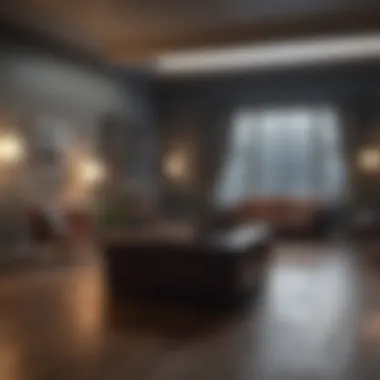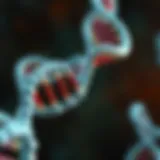The Science and Implications of Dim Light


Intro
Dim light is often overlooked in discussions about illumination and its impact on our lives. However, its effects stretch far beyond mere aesthetics. The way we experience dim light influences a variety of factors related to human health, technology, and our psychological well-being. Understanding these factors is crucial as we navigate an increasingly illuminated world. This article delves into the science behind dim light and examines its implications across different domains.
Recent Advances
Latest Discoveries
Recent research has provided new insight into how dim light affects human physiology. Studies suggest that exposure to low levels of light can significantly impact circadian rhythms. The body’s internal clock relies on light cues to regulate sleep patterns and hormone production. Disruptions to this system can lead to sleep disorders and other health issues. Researchers have found that the color temperature of dim light—specifically warmer tones—tends to be more conducive to relaxation and promoting sleep.
In psychological terms, dim light has been linked to mood regulation. A number of studies suggest that individuals exposed to soft, dim lighting tend to experience a reduction in stress levels. This contrasts with brightly lit environments, which can exacerbate anxiety.
Technological Innovations
The evolution of technology has played a pivotal role in how we manipulate dim light for our benefit. Innovations in LED lighting have allowed for a range of color temperatures and brightness levels that can be easily adjusted. Smart home technologies now enable users to control lighting through phone applications or voice commands. This flexibility is not only convenient but enhances overall well-being by allowing individuals to create an environment that supports their health needs.
Moreover, emerging applications of dim light in therapeutic settings show promise. For instance, research suggests that specific wavelengths of dim light may enhance healing processes in clinical environments. This approach opens up new avenues for enhancing patient experiences in hospitals and clinics.
Methodology
Research Design
The exploration of dim light and its implications spans multiple disciplines. Studies in the fields of psychology, biology, and technology employ a variety of research designs. Experimental designs often measure physiological responses under controlled lighting conditions. Surveys and observational studies provide insights into how individuals report their experiences in different lighting environments.
Data Collection Techniques
Data collection methods vary widely depending on the research question. Common techniques include:
- Controlled experiments: Participants may be exposed to different lighting conditions while measures such as heart rate and cortisol levels are monitored.
- Surveys and questionnaires: These tools gauge self-reported mood, stress, and sleep quality among participants exposed to various light levels.
- Technological monitoring: Wearable devices can track sleep patterns and physiological responses, providing invaluable data on how individuals react to dim light.
"Understanding how dim light operates on a biological and psychological level is essential for maximizing its benefits in our daily lives."
By synthesizing these findings, we can better appreciate the significance of dim lighting across various contexts. The implications are vast, ranging from personal health to technological advancement.
Understanding Dim Light
Dim light plays a significant role in our daily lives. Understanding it involves exploring various aspects, including biological, psychological, and technological implications. Dim light can influence human health and behavior, often in subtle yet profound ways. It is essential to examine the specific elements that contribute to its impact.
The importance of dim light lies in its ability to affect our circadian rhythms. These rhythms are natural processes that control the sleep-wake cycle, hormone release, and other bodily functions. In environments with low light, the body may adapt in various ways. This adaptability can lead to changes in melatonin production, mood, and overall well-being.
Another vital consideration is how dim light interacts with technology. The use of smart lighting solutions, for example, allows individuals to control their environment to create optimal conditions for work and relaxation. The understanding of dim light also prompts discussions about safety in darker settings and how to balance aesthetic with functionality.
Definition and Basics
Dim light is typically associated with lower levels of illumination. It is frequently described concerning intensity measured in lumens or lux. Understanding these measurements can clarify how we perceive light in various contexts. The World Health Organization identifies acceptable light intensity levels for different tasks, from reading to general ambient lighting.
Dim light exists in both natural settings, such as twilight or overcast skies, and artificial settings. In nature, dim light can create a soothing environment. Within urban landscapes, dim artificial lighting may be used for aesthetic appeal or energy conservation.
Measurement of Light Intensity
Measuring light intensity accurately is crucial when discussing dim light. Certain instruments, such as photometers or light meters, provide valuable data on illumination levels. These measurements help in assessing the suitability of light for various activities.
Factors to consider in light intensity measurement include:


- Type of Light Source: LED, incandescent, fluorescent, and natural light have different intensities.
- Distance from the Light Source: The intensity decreases as distance increases.
- Surface Reflection: Light can reflect off various surfaces, altering perceived intensity.
"Understanding how dim light is measured enhances our awareness of its effects and applications."
The functionality of dim light tends to vary by its context. In architectural design, there may be a fine balance between using dim lighting for ambiance while ensuring safety and visibility. Professional environments also require adequate analysis to ensure productivity is maintained amid lower lighting conditions. Overall, understanding dim light can offer insights into improving health, productivity, and well-being in many areas of life.
Physiological Effects of Dim Light
Dim light has a profound impact on various biological processes in the human body. Understanding these effects is crucial as they influence not just our health, but also our overall well-being. As modern society increasingly involves artificial lighting, recognizing how dim light interacts with our physiology is essential. The significance of this topic lies in its implications for sleep, mental health, and daily functioning.
Impact on Circadian Rhythms
Circadian rhythms refer to the natural, internal process that regulates our sleep-wake cycle and other bodily functions. These rhythms are influenced by environmental cues, predominantly light. Dim light exposure during evening hours can shift the timing of these rhythms, affecting alertness and sleepiness.
Research shows that exposure to low light levels during the evening can delay melatonin release, which is critical for signaling sleep. When melatonin levels rise, we experience increased drowsiness, paving the way for sleep onset. A disruption in this natural cycle can lead to sleep disorders, increased fatigue during the day, and diminished cognitive performance. Maintaining appropriate light levels is, therefore, necessary to help synchronize circadian rhythms, thereby supporting healthy sleep patterns.
Melatonin Production
Melatonin is a hormone primarily produced by the pineal gland in response to darkness. Its production is directly linked to light exposure. Under dim light conditions, melatonin levels remain higher, allowing for better sleep quality. However, in environments with significant artificial light exposure, especially blue light, melatonin production can decrease.
A reduction in melatonin leads to difficulty falling asleep and disrupted sleep cycles. This is why it is advised to limit exposure to screens and bright lights before bedtime. Understanding how dim light affects melatonin production can help individuals make choices that enhance their health and sleeping patterns.
Effects on Sleep Quality
The quality of sleep has far-reaching implications for physical and mental health. Low-intensity lighting can create a conducive environment for restful sleep. Dim light helps in achieving slower brain waves, leading to deeper stages of sleep. Conversely, exposure to bright light, especially during the evening, may lead to lesser quality sleep, resulting in less time spent in these restorative stages.
Studies indicate that individuals who expose themselves to dim light prior to sleep often report improved feelings of restfulness upon waking. It is evident that a careful assessment of lighting in living spaces can lead to improved sleep patterns, thereby enhancing overall health.
"A consistent dim lighting environment can significantly enhance melatonin release and overall sleep quality."
In summary, the physiological effects of dim light are crucial to understanding how we manage our environments for better health outcomes. By actively engaging with these insights, individuals can tailor their lighting experiences to foster well-being.
Psychological Responses to Dim Light
Understanding the psychological responses to dim light is crucial as it highlights how illumination levels can significantly affect human emotions, creativity, and overall behavior. In various settings, the manipulation of light is an essential aspect, influencing mental well-being and performance. Researchers increasingly focus on this area to uncover the profound implications dim lighting can have on our psychological state.
Mood Regulation
Dim light contributes to mood regulation in various ways. It has been noted that lower light levels can create a calming effect. This can help to reduce stress and anxiety, promoting relaxation. Studies show that when people are in softly lit environments, they often experience less tension and a sense of peace.
An environment with dim lighting is often associated with comfort. When individuals are comfortable, they are more likely to express positive emotions. For instance, restaurants and lounges often utilize soft lighting to enhance patrons' moods, creating social atmospheres that feel inviting. This effect of dim light has implications for both personal spaces and public environments.
"The modulation of light has proven to be a significant factor in emotional health."
Creativity and Dim Light
The interplay between dim light and creativity is a subject of interest among psychologists and designers. Research suggests that softer light can stimulate creative thinking. When people are exposed to such environments, cognitive flexibility may be enhanced, leading to improved problem-solving skills and innovative ideas.
A dimly lit room can encourage individuals to think outside the box. There are several explanations for this phenomenon. One theory posits that lower lighting levels can distract the mind from critical and analytical thinking, allowing for a more free-flowing thought process. More relaxed settings promote creativity, making them ideal for brainstorming sessions or artistic endeavors.
Behavioral Changes in Low Light
Behavioral changes in low light settings are noteworthy. Individuals may exhibit different actions or decision-making processes when in poorly lit environments. For example, research shows that dim lighting can lead to decreased inhibitions, which may promote risk-taking behaviors. In social contexts, this might lead to people being more open or engaged.
Furthermore, in darker conditions, the perception of time can alter, often leading individuals to underestimate how long they have been in such an environment. This has implications for how we design spaces, especially in retail or entertainment.


In summary, the psychological responses to dim light cover an essential area of study that integrates mood, creativity, and behavior. Understanding these aspects can guide better design in various settings to enhance well-being and functionality. It is clear that dim light holds significant meaning not only for physiological responses but also for our mental landscape.
Applications of Dim Light
The application of dim light holds considerable significance across diverse fields, notably in architectural design, nature-inspired environments, and therapeutic settings. Each of these domains benefits immensely from the tailored use of low light, improving not just aesthetics but also the well-being of individuals. Understanding these applications enlightens us on how dim lighting can enhance our daily experiences and interactions with spaces.
Architectural Design Considerations
In architecture, dim light is pivotal for creating atmospheres that resonate with various human emotions. The design process often incorporates lighting as a key element, affecting how spaces are perceived. Dim lighting can soften hard edges and create an inviting environment, which contrasts with harsh, bright illumination.
- Maximizing Natural Light: Architects use dim light in combination with natural light to create balanced, harmonious spaces. This blend often leads to energy savings and a more sustainable approach to design.
- Reinforcing Functionality: Specific areas like lounge zones or private offices might require softer illumination compared to bustling areas such as cafés or hallways. Dim lights can delineate spaces effectively.
- Emotional Impact: Studies show that dim lighting can elevate mood and promote relaxation, which is essential in spaces meant for social interaction or personal reflection.
Biophilic Design and Lighting
Biophilic design promotes a connection between humans and nature, emphasizing how dim light integrates with this philosophy. This design approach recognizes the importance of natural environments for mental and physical health.
- Natural Rhythm: Utilization of dim light mimics natural dusk and dawn, aligning with our biological rhythms. This can foster a greater sense of well-being and encourage a deeper connection with nature.
- Material Choice: Eco-friendly materials combined with controlled dimming can emphasize textures and colors that are reminiscent of nature. This serves to nurture psychological comfort and relaxation.
- Connection to Outdoors: Spaces designed with dim lighting in mind can maximize views of the outdoors, allowing occupants to feel more connected to their environment without harsh distractions.
Lighting in Therapeutic Environments
Dim light finds critical application in healthcare and therapy settings, influencing recovery, healing, and psychological comfort for patients. Appropriate lighting can help create a serene environment conducive to healing.
- Pain Management: Studies suggest that softer lighting can reduce perceived pain levels and anxiety, promoting a sense of calmness among patients.
- Mood Disorders: In environments such as mental health facilities, strategic use of dim light can alleviate symptoms of mood disorders like depression.
- Focus and Relaxation: In spaces for meditation or recovery, low light fosters an atmosphere that encourages focus, introspection, and relaxation, catering to the needs of individuals seeking relief from stress.
"Dim light can play a transformative role in healing environments, impacting overall patient satisfaction and recovery times."
As evident, the applications of dim light underscore its importance in various domains. Each application leverages the unique qualities of dim lighting to enhance quality of life, improve mental well-being, and support functional design.
Technological Innovations in Dim Lighting
The evolution of dim lighting technologies has substantially transformed many aspects of human environments, shaping how we interact with spaces and each other. This section explores innovations that enhance the functionality and efficiency of dim lighting solutions, emphasizing their significance in both residential and commercial settings. The advancements in technology help create adaptable environments that cater to individual human needs and preferences.
Smart Lighting Solutions
Smart lighting systems have redefined the experience of dim light. These solutions often integrate advanced sensors and connectivity features that allow for real-time adjustments based on occupancy and ambient light levels. Homeowners can now control their lighting remotely or program it to respond automatically to their daily routines.
Benefits of smart lighting include improved convenience, enhanced energy savings, and increased customization. For instance, systems like Philips Hue and Lutron Caseta allow users to set specific scenes, changing the intensity and hue of light according to their preferences or activities, such as reading or relaxing. Moreover, these systems enable users to program different lighting scenarios for various times of the day, aligning with circadian rhythms and supporting overall well-being.
Energy Efficiency in Low Light Technologies
Energy efficiency in dim lighting technologies is essential, especially in a world increasingly aware of its carbon footprint. Innovations like LED technologies have revolutionized how low light is generated and used. LEDs consume less power than traditional light bulbs while providing a longer lifespan and lower heat output.
The implementation of dimmable LEDs further enhances energy efficiency. By adjusting the brightness according to need, users can significantly reduce energy consumption. Cities and urban planners are also integrating energy-efficient dim lighting into street lighting systems to maintain safety while minimizing electricity use.
"Innovating energy-efficient solutions not only supports environmental objectives but also offers substantial cost savings for consumers and businesses alike."
In addition, there is increased interest in solar-powered dim lighting systems, which harness renewable energy. These systems contribute to sustainability and are particularly useful in remote areas lacking grid access.
The intersection of technology and dim lighting not only impacts how we illuminate our spaces, but also suggests a shift toward smarter, more sustainable living, making it a crucial component in future developments. By embracing these advancements, we have the potential to improve health, increase safety, and promote environmental responsibility.
Cultural Perspectives on Dim Light
The examination of dim light within cultural contexts reveals significant insights into how societies interpret and utilize lighting. Different cultures have imbued dim light with various meanings, often associating it with tranquility, introspection, or reverence. This section delves into two important aspects: the historical context of lighting practices and the role of dim light in religious and ceremonial settings.
Historical Context of Lighting Practices


Historically, the sources of light have dictated how societies engage with their environments. Before the advent of electricity, humanity relied on natural sources like fire, candlelight, and oil lamps. Each of these provided a limited, often flickering glow that created shadows and a sense of intimacy.
For example, ancient cultures employed torches and oil lamps in ceremonial practices, creating a mystical ambiance that facilitated communal gatherings. The dimness of the light encouraged a social atmosphere that fostered conversation and connection.
With the introduction of gas and then electric lighting, the approach to lighting shifted dramatically. Dim light became less common for everyday tasks but remained vital in specific settings, particularly religious and ceremonial spaces. The capacity to adjust light levels allowed for a more intentional use of shadow and light, shaping social interactions and cultural rituals.
Dim Light in Religious and Ceremonial Settings
Dim light holds considerable significance in many religious traditions around the world. It often symbolizes a connection to the divine or the mysterious. Rituals conducted in low light foster a contemplative atmosphere that can enhance the spiritual experience.
- Christianity: In many Christian practices, dim lighting is used during evening services and rituals like vesper or candlelight services, emphasizing reflection and serenity.
- Hinduism: During Diwali, the festival of lights, the use of dim lighting from diyas creates a sacred space that encourages mindfulness and the celebration of victory over darkness.
- Buddhism: Monasteries frequently utilize dim light to support meditation practices, allowing practitioners to focus inward and attain clarity.
The use of dim light in these settings is not merely aesthetic; it is deeply intertwined with the spiritual experience. As individuals engage in worship or ceremony, low light helps to reduce external distractions, inviting participants to connect with their inner selves and the higher powers they believe in.
"Dim light creates an ambience that invites reflection and solemnity, encouraging deeper connection with spiritual practices."
Challenges and Considerations
The topic of challenges and considerations surrounding dim light is crucial for understanding its full impact on health and safety. Dim lighting, while often seen as soothing or conducive to relaxation, comes with its own set of potential risks and benefits. A balanced view of these challenges is essential.
Health Risks of Prolonged Dim Lighting
Prolonged exposure to dim light can pose several health risks. One of the main concerns relates to the effect it has on sleep patterns. When people spend extensive time in dimly lit environments, their circadian rhythms may be disrupted. As research suggests, such disturbances can lead to chronic sleep issues, which are often tied to various health problems like obesity, heart disease, and mental health disorders.
Additionally, dim light can impair vision over time. The eyes naturally require more effort to see in low light conditions. This increased strain can contribute to conditions such as eye fatigue and discomfort, and in some cases, may accelerate the development of conditions like myopia.
"Long-term exposure to inadequate lighting can lead to a cycle where poor vision leads to more dimly lit environments, causing numerous health issues."
Furthermore, dim lighting may affect mood and cognitive functions. Studies have shown that environments lacking sufficient light can contribute to feelings of fatigue, irritability, and even depression. This is particularly relevant in office spaces or homes where lighting does not support well-being.
Balancing Dim Light and Safety
Finding the right balance between dim lighting and safety is essential in several contexts. In environments such as streets or public spaces, too much dimness can increase risks of accidents. A poorly lit street may contribute to higher instances of falls, injuries, or even crime. Ensuring adequate lighting in these areas can be a simple yet effective way to enhance public safety.
On the other hand, dim light has applications in residential settings and relaxation spaces. Properly designed lighting can provide a calming atmosphere while still maintaining safety. Using adjustable lighting options can make it possible to enjoy the benefits of both dimness and adequate visibility.
Here are considerations for balancing dim light with safety:
- Purpose of the Space: Understand whether the situation requires bright light or if a more subdued atmosphere is suitable.
- Lighting Technology: Smart lighting systems allow for adjustment of brightness based on activity or time of day, promoting safety without sacrificing comfort.
- Multi-Zone Lighting: Using layers of light can help manage different areas effectively, allowing for dim light zones while keeping pathways or working areas illuminated.
In summary, challenges related to prolonged dim lighting and balancing it with safety play significant roles in various applications of light. By taking these challenges into account, individuals and organizations can work towards creating environments that support health while ensuring safety.
Future Directions in Dim Light Research
The study of dim light continues to evolve, reflecting shifts in both scientific inquiry and societal needs. As we become more aware of the profound effects of dim lighting on human health, behavior, and the environment, the future of research in this area becomes increasingly critical. This section highlights specific trends and considerations that merit attention as we navigate the complex interplay between dim light and our ways of living.
Emerging Research Trends
Recent studies reveal a growing interest in how dim light influences various aspects of human biology and psychology. Key trends include:
- Light Spectrum Investigations: Researchers are probing how different wavelengths of light in dim environments affect mood and circadian rhythms. For instance, blue light exposure during twilight is now recognized for its potential to disrupt melatonin production, which may impact sleep.
- Technological Advancements: Investigations into smart lighting technologies are expanding, focusing on adaptive lighting systems that adjust based on natural light conditions. These systems aim to optimize well-being in residential and workspaces.
- Behavioral Responses: There is an increasing emphasis on the psychological effects of dim light on creativity and decision-making. Current studies are exploring the hypothesis that low-light conditions can foster innovative thinking but might impair analytical reasoning.
- Interdisciplinary Approaches: Collaboration between psychology, neuroscience, and architecture is burgeoning. This multidimensional approach aims to create environments that support mental health and productivity through optimal lighting conditions.
Potential Impacts on Urban Planning
As urban spaces grow more populated and complex, understanding the role of dim light in city planning becomes essential. Some potential impacts include:
- Safety Considerations: Planners must consider how dim lighting affects visibility and safety. Inadequate lighting can lead to increased accidents and crime rates.
- Public Health Enhancements: Urban spaces that incorporate dim light in thoughtful ways—such as parks and social areas—can support mental health and community well-being. Research indicates that leisurely low-light environments can reduce stress and promote social interaction.
- Sustainability Practices: There is a strong drive toward using energy-efficient dim lighting solutions that reduce carbon footprints. Urban designs that integrate smart lighting systems can enhance energy savings while providing adequate illumination.
- Community Engagement: Engaging the community in discussions around lighting design can help planners create spaces that enhance experiences and foster a sense of belonging. Public forums can gather insights on how different lighting schemes affect public spaces.
"The interplay between urban planning and dim light is an underexplored area. Properly integrated, dim lighting can transform the urban experience, enhancing both livability and safety."
The future of dim light research is vital to addressing contemporary challenges in health and urban environments. By fostering a deeper understanding of how dim light interacts with human experience, we can better prepare for the implications it holds for our dynamically changing world.















